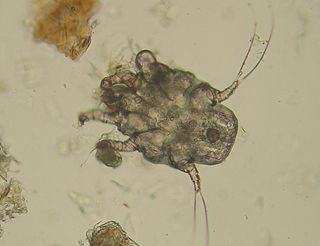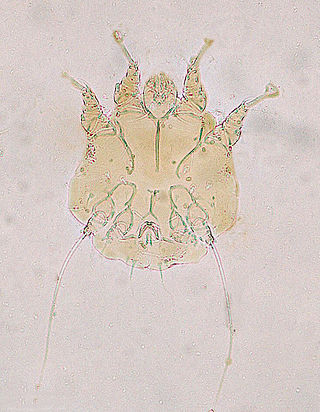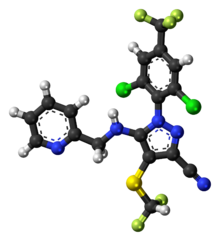
Permethrin is a medication and an insecticide. As a medication, it is used to treat scabies and lice. It is applied to the skin as a cream or lotion. As an insecticide, it can be sprayed onto outer clothing or mosquito nets to kill the insects that touch them.

Mange is a type of skin disease caused by parasitic mites. Because various species of mites also infect plants, birds and reptiles, the term "mange", or colloquially "the mange", suggesting poor condition of the skin and fur due to the infection, is sometimes reserved for pathological mite-infestation of nonhuman mammals. Thus, mange includes mite-associated skin disease in domestic mammals, in livestock, and in wild mammals. Severe mange caused by mites has been observed in wild bears. Since mites belong to the arachnid subclass Acari, another term for mite infestation is acariasis.

Demodicosis, also called Demodex folliculitis in humans and demodectic mange or red mange in animals, is caused by a sensitivity to and overpopulation of Demodex spp. as the host's immune system is unable to keep the mites under control.
Skin disorders are among the most common health problems in dogs, and have many causes. The condition of a dog's skin and coat is also an important indicator of its general health. Skin disorders of dogs vary from acute, self-limiting problems to chronic or long-lasting problems requiring life-time treatment. Skin disorders may be primary or secondary in nature, making diagnosis complicated.

Fipronil is a broad-spectrum insecticide that belongs to the phenylpyrazole chemical family. Fipronil disrupts the insect central nervous system by blocking the ligand-gated ion channel of the GABAA receptor and glutamate-gated chloride (GluCl) channels. This causes hyperexcitation of contaminated insects' nerves and muscles. Fipronil's specificity towards insects is believed to be due to its greater binding affinity for the GABAA receptors of insects than to those of mammals, and for its action on GluCl channels, which do not exist in mammals. As of 2017, there does not appear to be significant resistance among fleas to fipronil.

Selamectin, sold under the brand name Revolution, among others, is a topical parasiticide and anthelminthic used on dogs and cats. It treats and prevents infections of heartworms, fleas, ear mites, sarcoptic mange (scabies), and certain types of ticks in dogs, and prevents heartworms, fleas, ear mites, hookworms, and roundworms in cats. It is structurally related to ivermectin and milbemycin. Selamectin is not approved for human use.

Ear mites are mites that live in the ears of animals and humans. The most commonly seen species in veterinary medicine is Otodectes cynotis. This species, despite its name, is also responsible for 90% of ear mite infections in felines.

Cheyletiella is a genus of mites that live on the skin surface of dogs, cats, and rabbits.

The cat flea is an extremely common parasitic insect whose principal host is the domestic cat, although a high proportion of the fleas found on dogs also belong to this species. This is despite the widespread existence of a separate and well-established "dog" flea, Ctenocephalides canis. Cat fleas originated in Africa but can now be found globally. As humans began domesticating cats, the prevalence of the cat flea increased and it spread throughout the world.

Nitenpyram is a chemical frequently used as an insecticide in agriculture and veterinary medicine. The compound is an insect neurotoxin belonging to the class of neonicotinoids which works by blocking neural signaling of the central nervous system. It does so by binding irreversibly to the nicotinic acetylcholine receptor (nACHr) causing a stop of the flow of ions in the postsynaptic membrane of neurons leading to paralysis and death. Nitenpyram is highly selective towards the variation of the nACHr which insects possess, and has seen extensive use in targeted, insecticide applications.

The dog flea is a species of flea that lives as an ectoparasite on a wide variety of mammals, particularly the domestic dog and cat. It closely resembles the cat flea, Ctenocephalides felis, which can live on a wider range of animals and is generally more prevalent worldwide.

Metaflumizone is a semicarbazone insecticide indicated for the veterinary treatment of fleas and ticks, marketed under the brand name ProMeris. A discontinued variant of ProMeris, called ProMeris Duo or Promeris for Dogs, was indicated for canine use and was a formulated blend of metaflumizone and amitraz. The metaflumizone-only formulation is waterproof and typically remain effective for 30–45 days in a cutaneous application at the base of the neck.

Mites that infest and parasitize domestic animals cause disease and loss of production. Mites are small invertebrates, most of which are free living but some are parasitic. Mites are similar to ticks and both comprise the order Acari in the phylum Arthropoda. Mites are highly varied and their classification is complex; a simple grouping is used in this introductory article. Vernacular terms to describe diseases caused by mites include scab, mange, and scabies. Mites and ticks have substantially different biology from, and are classed separately from, insects. Mites of domestic animals cause important types of skin disease, and some mites infest other organs. Diagnosis of mite infestations can be difficult because of the small size of most mites, but understanding how mites are adapted to feed within the structure of the skin is useful.
Imidacloprid/permethrin/pyriproxyfen, sold under the trade name K9 Advantix II, is a combination insecticide product for dogs, used for the treatment and prevention of an array of common external parasites. It is effective against fleas, ticks, chewing lice and mosquitoes. The active ingredients are imidacloprid, permethrin, and pyriproxyfen. This product is toxic to cats, and it is not recommended to use it on dogs which share an environment with cats. The product is applied onto the skin; administration of the product into the mouth can cause adverse effects.

Fluralaner (INN) is a systemic insecticide and acaricide that is administered orally or topically. The U.S. Food and Drug Administration (FDA) approved it under the trade name Bravecto for flea treatment in dogs in May 2014 and Bravecto Plus as a topical treatment for cats in November 2019, with warnings about possible side effects in both species. The EU approved the drug in February 2014. Australia approved it for the treatment and prevention of ticks and fleas on dogs in January 2015. For treating mites in chickens, a solution for use in drinking water is available under the name Exzolt; it was introduced by the EU in 2017.
Flea treatments are procedures used to treat flea infestations in human or animal populations. They may treat both the itching caused by bites and may remove or kill the fleas themselves.

Afoxolaner (INN) is an insecticide and acaricide that belongs to the isoxazoline chemical compound group.

Lotilaner, sold under the brand name Xdemvy, is an ectoparasiticide (anti-parasitic) medication used for the treatment of blepharitis caused by infestation by Demodex. It is used as an eye drop.

Notoedric mange, also referred to as Feline scabies, is a highly contagious skin infestation caused by an ectoparasitic and skin burrowing mite Notoedres cati. N. cati is primarily a parasite of felids, but it can also infest rodents, lagomorphs, and occasionally also dogs and foxes. This skin disease also has zoonotic potential. Infestation is also called acariasis, which refers to a rash that is caused by mites.

















